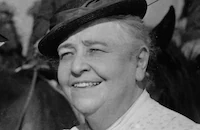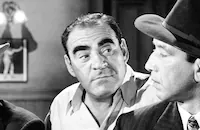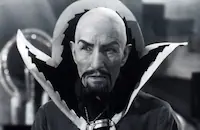Brigham Young--Frontiersman
Brief Synopsis
Cast & Crew
Henry Hathaway
Tyrone Power
Linda Darnell
Dean Jagger
Brian Donlevy
Jane Darwell
Film Details
Technical Specs

Synopsis
In the 1840's, when his followers are persecuted once again as a vigilante mob torches their meeting place and slays several of their members, Illiinois Mormon leader Joseph Smith urges his followers to take up arms and defend themselves. For his admonition, Smith is arrested on a charge of treason and found guilty, but before he can be sentenced, he is murdered in cold blood. Brigham Young reluctantly assumes leadership of the group and tired of violence, he decides to lead his followers out of Illinois after the army warns that they can no longer protect his people. This decision places Brigham in conflict with church member Angus Duncan, who urges the group to stay. The congregation, however, decides to follow Brigham, who leads them across an icy river to Iowa and across the great plains of the West. Joining them is outsider Zina Webb, who accepts the Kent family's offer of a home after the elder Kent is killed during one of the raids on the Mormons. On the road West, word comes of gold in California and, after Brigham falls ill, Duncan seizes leadership to lead the band to California. As they are traveling through the mountains of Utah, Brigham suddenly awakens in the hills above the great Salt Lake to announce that he has had a revelation and has learned that this is where they will settle. During the harsh winter, however, supplies run low and some of the women and children perish. Things look their darkest in the spring when a plague of crickets threatens the crop of wheat and Zina falls ill from starvation. Jonathan Kent has asked Zina to marry him, but as she lies stricken in her bed, his faith is tested. Brigham also has doubts, but just at the moment that he is about to renounce his leadership, a flock of seagulls appears from the skies to destroy the crickets and rekindle the faith of the Mormons.

Director

Henry Hathaway
Cast

Tyrone Power

Linda Darnell

Dean Jagger

Brian Donlevy

Jane Darwell

John Carradine

Mary Astor

Vincent Price

Jean Rogers

Ann Todd
Willard Robertson

Moroni Olsen
Marc Lawrence
Stanley Andrews
Frank [m.] Thomas

Fuzzy Knight

Dickie Jones
Selmer Jackson
Frederick Burton
Arthur Aylesworth
Chief Big Tree
Davidson Clark
Claire Du Brey

Tully Marshall
Dick Rich

Ralph Dunn
Edwin Maxwell
Edmund Macdonald
George Melford
Russell Simpson

Charles Halton
David Kirkland
Lee Shumway

Charles Middleton
Philip Morris
Frank La Rue
Paul Burns
Frank Shannon
William Haade
Herbert Heywood
Edmund Elton
Harry Tyler
Eddy Waller
Cecil Weston
Ruth Robinson
Imboden Parrish
Murdock Mac Quarrie
Crew
Robert Bischoff
Louis Bromfield
Otto Brower
William Darling
Charles Hall
Eleanor Harris
Roger Heman
Thomas Little
Kenneth Macgowan
Arthur Miller
Alfred Newman
George D. Pyper
Maurice Ransford
Ad Schaumer
Fred Sersen
Lamar Trotti
Gwen Wakeling
E. Clayton Ward
Darryl F. Zanuck

Film Details
Technical Specs

Articles
Brigham Young-Frontiersman - Brigham Young - Frontiersman
The movie opens in the town of Nauvoo, Illinois in 1844. After Joseph Smith, the founder of the Church of Jesus Christ of Latter Day Saints, is assassinated, Brigham Young (Dean Jagger) leads his followers via wagon train to Nebraska, where they temporarily settle, then on to Utah. Portions of the film focus on a young couple (Power and Linda Darnell) whose devotion to each other must survive the tumultuous journey.
Power agreed to take on a supporting role in Brigham Young-- Frontiersman both because studio head Darryl Zanuck asked him to, and also because of his close relationship with Hathaway. The two men had already collaborated on a gangster melodrama called Johnny Apollo (1940), and Power far preferred Hathaway's guidance to that of the forever-intruding Zanuck.
Although at this point in his career Power was often presented as little more than a handsome, charismatic presence in movies, Hathaway recognized that the actor was an intelligent, committed professional who always had his lines memorized in the morning and was focused on the work at hand...which, unfortunately, was more than one could expect from many stars of Power's magnitude.
Hathaway and Power began work on Brigham Young-- Frontiersman very soon after completing Johnny Apollo. Zanuck, who cooked up the concept for the film himself, was convinced that Jagger, a successful supporting player at the time, could make the jump to leading man status with the right part. But he also felt Power's draw would bolster the picture's box office - and it did, though the movie still lost money.
Zanuck wasn't particularly interested in actual Mormonism; the narrative theoretically focuses on the ordeal of some 20,000 people making a harrowing journey from Illinois to the Great Salt Lake, where, of course, Young's church was founded. Zanuck viewed the story as an American equivalent of the Israelites trekking across the desert in search of the Promised Land, sort of an updated Biblical epic, except that no less than ten romantic interludes between Power and Darnell were written into the screenplay because Zanuck had received thousands of letters from fans complaining that Power didn't see enough amorous action in his pictures. Periodically, then, the suffering of thousands hits a backburner.
The filming of Brigham Young -- Frontiersman was no small undertaking. Hathaway insisted on a location shoot, so the entire cast and crew traveled between the Utah desert, the Sierra Nevada Mountains, and Big Bear Lake for several weeks. Second Unit director Otto Bower also shot for six weeks throughout Utah, and hit a jackpot of sorts when he stumbled upon a plague of locusts gnawing away in the hamlet of Elko, Nevada.
Power hated the part he was asked to play, but he and Hathaway attempted to make the best of it by turning the 133 day shoot into a lengthy gathering of friends. It resulted in a lot of barbecues, and Power, an animal lover, was able to spend leisure time with Lady, his German Shepherd. If only Young and his flock had had it so good.
Director: Henry Hathaway
Producer: Kenneth Macgowan
Screenplay: Lamar Trotti, Louis Bromfield
Cinematographer: Arthur Miller
Editor: Robert Bischoff
Music: Alfred Newman
Art Direction: William Darling, Maurice Ransford
Cast: Tyrone Power (Jonathan Kent), Linda Darnell (Zina Webb), Dean Jagger (Brigham Young), Brian Donlevy (Angus Duncan), Jane Darwell (Eliza Kent), John Carradine (Porter Rockwell), Mary Astor (Mary Ann Young), Vincent Price (Joseph Smith), Jean Rogers (Clara Young).
B&W-113m.
by Paul Tatara

Brigham Young-Frontiersman - Brigham Young - Frontiersman
Marc Lawrence (1910-2005)
Born Max Goldsmith on February 17, 1910, in the Bronx, Lawrence had his heart set on a career in drama right out of high school. He enrolled at City College of New York to study theatre, and in 1930, he worked under famed stage actress Eva Le Gallienne. Anxious for a career in movies, Lawrence moved to Hollywood in 1932 and found work immediately as a contract player with Warner Bros. (an ideal studio for the actor since they specialized in crime dramas). He was cast as a heavy in his first film, If I Had a Million (1932). Although his first few parts were uncredited, Lawrence's roles grew more prominent: a sinister henchman in the Paul Muni vehicle in Dr. Socrates (1935); a conniving convict aiding Pat O'Brien in San Quentin (1937); a menacing thug stalking Dorothy Lamour in Johnny Apollo (1940); the shrewdly observant chauffeur in Alan Ladd's breakthrough hit This Gun For Hire (1942); and one of his most memorable roles as Ziggy, a fedora wearing mobster in the Bogart-Bacall noir classic Key Largo (1948).
Lawrence, when given the opportunity, could play against type: as the prosecuting attorney challenging Tyrone Power in Brigham Young (1940); a noble aristocrat in the Greer Garson-Walter Pidgeon period opus Blossoms in the Dust; and most impressively, as a deaf mute simpleton in the rustic drama The Shepherd of the Hills (both 1941). Better still was Lawrence's skill at comedy, where his deadpan toughness worked terrifically as a straight man against the likes of Joe E. Brown in Beware Spooks (1939); Abbott and Costello in Hit the Ice (1943); Penny Singleton in Life with Blondie (1945); and Bob Hope in My Favorite Spy (1951).
After that, Lawrence's career took a turn downward spin when he was labeled a communist sympathizer during the Hollywood witch hunts of the early '50s. He was exiled in Europe for a spell (1951-59), and when he came back, the film industry turned a blind eye to him, but television overcompensated for that. Here he played effective villains (what else?) in a series of crime caper programs: Peter Gunn, Johnny Staccato, The Untouchables, Richard Diamond, Private Detective; and eventually made a welcome return to the big screen as a returning exiled gangster in William Asher's underrated mob thriller Johnny Cool (1963).
It wasn't long before Lawrence found himself back in the fray playing in some big box-office hits over the next two decades: Diamonds Are Forever (1971), The Man with the Golden Gun (1974), Marathon Man (1976), Foul Play (1978); and The Big Easy (1987). Sure he was cast as a gangster, but nobody could play a rough and tumble mob boss with more style or conviction.
Interestingly, one of his finest performances in recent years was in television, as a severely ill old man unwilling to accept his fate in a fourth season episode of ER (1997-98). His last screen role was just two years ago, as a nimble minded VP in Looney Tunes: Back in Action (2003).
In 1991, Lawrence published a memoir about his venerable career, Long Time No See: Confessions of a Hollywood Gangster that received much critical acclaim. He has also developed a cult following due to his appearances in such offbeat items as From Dusk to Dawn and Pigs aka Daddy's Deadly Darling, the 1972 horror film he directed and starred in with his daughter Toni. He is survived by his wife, Alicia; two children from a previous marriage, Toni and Michael; and a stepdaughter Marina.
by Michael T. Toole
Marc Lawrence (1910-2005)
Quotes
Trivia
Notes
Although the film's title was listed as Brigham Young by the program for its August 1940 premiere in Salt Lake City, several preview reviews and some current prints, national reviews in September 1940 and later release charts gave the film's title as Brigham Young-Frontiersman. The opening title card of the viewed print read: "Twentieth Century-Fox presents Darryl F. Zanuck's Production of Brigham Young by Louis Bromfield." In the opening cast credits, Tyrone Power's character was listed as "Jonathan Kent, the Morman Scout," and Linda Darnell was credited as "Zina Webb, the Outsider."
Brigham Young (1801-1877) was an American Mormon leader and territorial governor of Utah. According to records contained in the Twentieth Century-Fox Produced Scripts Collection at the UCLA Theater Arts Library, Darryl Zanuck suggested Preston Foster for the role of "Joseph Smith," Brenda Joyce for "Zina," Richard Greene for "Jonathan Kent," Kay Francis for "Mary Ann," Margaret Hamilton for "Zenobia," Spring Byington for "Mother Webb" and Robert Barratt for the "Boston preacher." The Fox Story Files also disclose that writer Louis Bromfield worked on a treatment with Eleanor Harris and James Woolley. A later item in Hollywood Reporter notes that Harris had to sue Fox to receive her credit for story research. Woolley's contribution to the final film has not been determined. George Pyper, a Mormon leader and authority on Mormon history, served as technical advisor on the picture.
News items in Hollywood Reporter add that the trek scenes were shot by Otto Brower on location in Kanab, UT. The cricket plague scenes were filmed in Elko, NV. The crickets formed a band two miles wide and six miles long, moving at a half-mile per day. Other scenes in the film were shot at Lone Pine, Big Bear and Mt. Whitney, CA.














